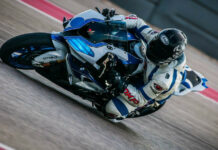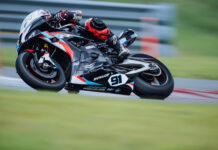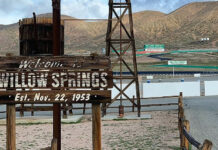The MotoGP World Championship crosses its halfway point at the German Grand Prix, round ten of eighteen on the 2007 calendar. The teams and riders are ready for another challenging double-header, with races at Sachsenring and Laguna Seca coming on consecutive Sundays before the summer break. Currently lying sixth in the championship on 87 points, just one behind Chis Vermeulen (5th), Marco Melandri is ready to tackle Sachsering, motivated to score a good result after the difficult race weekend in Assen. Meanwhile, back in Spain, Toni Elias is continuing with his recovery from the broken left femur he picked up at Assen. After spending a few days under observation at the Dexeus Institute in Barcelona, where he has been treated by Doctor Xavier Mir, Toni is now able to continue his rehabilitation at home. His return is pencilled in for either Brno on August 19th or Misano on September 2nd. Toni will be replaced by the 22 years old Italian rider Michel Fabrizio for the German event at Sachsenring. The replacer rider for the Grand Prix of the United States will be Miguel Duhamel, the rider of Honda USA. MARCO MELANDRI: “The next two circuits are really interesting and the Germany-USA double header will be really demanding. Sachsenring is a unique circuit but I like it because it is so flowing. At such a slow and twisty track the setting of the bike has to be perfect. Hopefully we can have a good session on Friday and find a good compromise for the set-up. From a rider’s perspective it is important to control the throttle and not be too aggressive.” MCHEL FABRIZIO: “I’m very happy to have another opportunity to ride the Honda Motogp after the unlucky launch last year at Donington Park, while I was replacing Toni. I’m very excited and I hope to score a better result this year. I have raced at Sachsenring in 2004, this experience may help me in the knowledge of the track. I’m enthusiastic and I thank Fausto Gresini for this great chance”. SACHSENRING – SET-UP EXPLAINED: Riders often talk about the ‘setting’ of their bikes, when asked to explain their performance in a practice session or race. It is a broad concept, which requires great experience and professionalism to understand, and now the Team Gresini Honda engineers face one of their biggest challenges as they try to adapt the machines from the demands of a fast and lowing circuit such as Assen to the tight and twisty nature of Sachsenring. “Assen requires a motorcycle that can turn well through the slow sections but have the power to excel in the fast sections which are taken with the throttle wide open,” explains Antonio Jimenez, Marco Melandri’s Chief Engineer. “Sachsenring, however, is a circuit that doesn’t have a long straight or any fast sections – even the main straight is only taken in fourth. The rest of the circuit is made up of second and third gear corners so the cycle part of the bike is extremely important, as well as a sweet and progressive power delivery, particularly in low revs. The gearbox also comes under a lot of strain because the riders spend so much time in either second or third.” “You need a bike that turns well,” adds Fabrizio Cecchini, Chief Engineer for Toni Elias. “Compared to Assen you need a softer setting on the front forks and rear shock.” Once again the biggest unknown factor this weekend could be the weather, which is extremely unpredictable in this part of Germany. Track temperatures can vary between 22° and 50°. Tyre choice is therefore crucial and can only be made once the teams arrive at the track. There are other factors that affect tyre choice at Sachsenring, namely the prevalence of left-hand corners (10 to be exact), which require the riders to spend lots of time on the edge of the tyre. THE TRACK: Located around 100km south of Dresden in the former East Germany, Sachsenring has hosted road races since the 1920s. The final Grand Prix held on the old circuit was in 1972 (when Giacomo Agostini took victory in the 500cc race), when the track measured 8.6km in length. In 1996 a new venue was created just a few kilometres from Chemnitz and it has been changed on a few occasions since then with the aim of making it faster.The latest update took place in 2003 but the German circuit remains the slowest on the current MotoGP calendar. Its tight and twisty nature makes it an interesting circuit to watch races at but it is also very demanding and therefore not a favourite of the MotoGP riders, with few places to overtake. The importance of outright horsepower makes way for a balanced chassis, which is particularly crucial in the slow and tight first half of the track. THE TRACK Constructed: 1996 Modified: 2003 Length: 3671 m Width: 10 m Pole: Left Right corners: 4 Left corners: 10 Longest straight: 780m
Fabrizio Looking To Do Better Than The Last Time He Filled In For Elias
Fabrizio Looking To Do Better Than The Last Time He Filled In For Elias
© 2007, Roadracing World Publishing, Inc.






